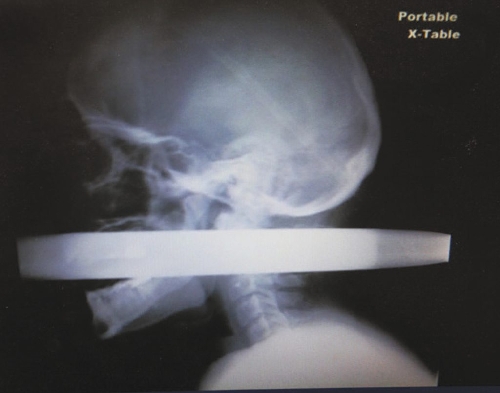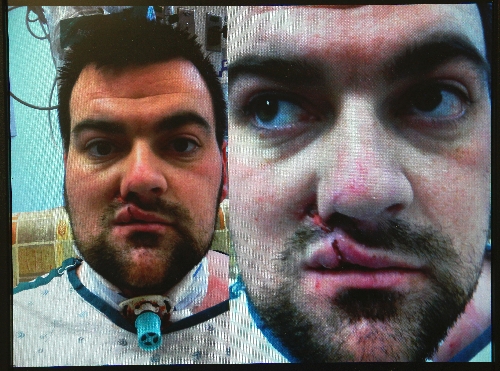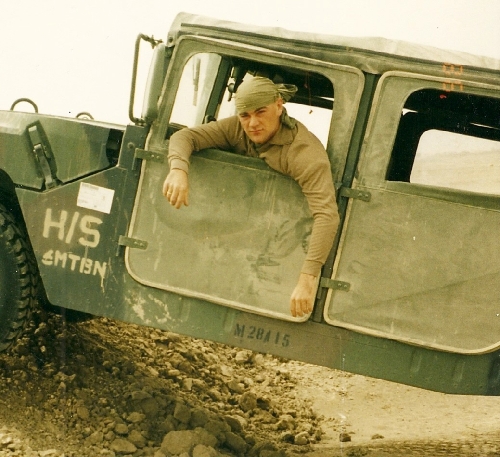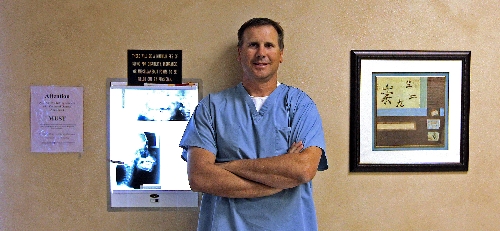Las Vegas native survives pipe through head thanks to doctors






The paramedic’s radio transmission to the University Medical Center Trauma Center gave Dr. Jay Coates just a hint of what was coming.
“We’re bringing in a patient with a foreign object impaled in his mouth.”
What wasn’t said was that the foreign object was a 2-inch diameter metal pole that had been driven through the man’s mouth and out through his neck.
“What the (expletive) am I going to do with this?” Coates remembered saying as he looked at the man sitting before him with 4 to 6 inches of pole sticking out of his mouth and neck. “I had to form a game plan fast.”
Coates looked again at the gruesome pictures of Andrew Linn on Monday morning in the trauma center office. It still boggles the doctor’s mind that the 28-year-old Linn was conscious when he was brought in, trying hard to talk with a pipe stuck through his head.
“I had never seen anything like it before,” said Coates, the same surgeon who saved magician Roy Horn’s life in 2003 after he was dragged offstage by a tiger. “How do you end up surviving a pipe going through your head like this?”
Emergency rescue personnel later would tell Linn that he had driven his car off the pavement near Bonanza Road and Christy Lane and hit a chain-link fence in a homeowner’s yard. A pole fastened atop the fence broke through the windshield, went through Linn just below the right side of his nose and ripped out teeth before slamming through the back window.
Rescuers had to cut the pole to get him out of the car and into an ambulance. He couldn’t lie down because of the pole, so he sat up on the ride to the hospital and through his initial surgery.
Linn’s brush with death in the early morning hours of Nov. 29 will be one of several miraculous stories shared today at UMC’s annual trauma survivor’s luncheon at Palace Station. Two people who survived lightning strikes also will be on hand.
Though Linn will be there, don’t expect the Marine Corps veteran of the Iraq War to be one of the storytellers.
Not because he can’t talk, but because he can’t remember.
He will thank the UMC medical team — Coates, oral surgeon Dr. Jeff Moxley and cardiovascular surgeon Dr. Nancy Donahoe — for saving his life.
Linn, a Las Vegas native, is a business marketing student at Southern Utah University. He and his wife and two children had driven back home for Thanksgiving weekend when the accident happened.
“All I remember is going to bed after a dinner and then waking up in a hospital,” he said in a phone interview from his Cedar City, Utah, home. “After seeing the pictures of the pole through my mouth and head that they took at the hospital, I’m glad I don’t remember. It really upsets my wife to see those pictures.”
He now theorizes that he woke up hungry late at night and drove to get a hamburger.
“I must have fallen asleep at the wheel,” he said.
He said that firefighters told him later he wasn’t rude as they worked to get him out of the car.
“When they finally got me out of the car, they said I jumped onto the gurney,” he said. “They said they told me to be careful, that I might hurt myself. They also said that I took out my phone and was trying to text someone. I was obviously in shock.”
Soon after Linn arrived at UMC, Coates had an X-ray done. It showed that the pole had missed Linn’s spine. He called in Moxley and Donahoe to help with the case.
“I knew that if Linn made it, he’d need a lot of oral surgery, and I brought in Dr. Donahoe in case we had problems with his carotid artery and jugular vein,” he said. “I was worried they might explode when we tried to pull the pipe out and Dr. Donahoe could try to tie them off before he bled to death. “
Before Coates cut Linn open to examine just what internal damage had been done, he had do a tracheostomy: create a hole in the front of Linn’s neck and into his windpipe.
Without the tracheostomy, there was no way that a breathing tube could be put into his mouth for an exploratory operation under general anesthesia.
“That metal pole was blocking everything,” Coates said.
The tracheostomy was done under local anesthesia.
“I don’t remember him complaining or moaning in pain at all that night,” Coates said. “The body really has a way of protecting us.”
After Coates was assured the tracheostomy allowed Linn to breathe under general anesthesia, he put him out and then made an incision behind his right ear down to the base of his neck.
To his surprise, neither he nor Donahoe found the jugular vein or carotid artery visibly affected by the trauma.
“I couldn’t see all of the artery, though, so I was really afraid it might break loose when we pulled it out through the mouth,” he said.
It was Moxley’s job to pull the pipe out.
Before he began to pull, the back of the pipe behind Linn’s head had to be recut.
“There were some really sharp edges from where the rescue workers cut it to get him out of the car,” Moxley said. “We were afraid that when we pulled the pipe through his head, it would cut something.”
Just before Moxley began to pull on the pipe, Coates remembered that the team looked at one another and the tension level rose. Blood soon could be spewing from Linn’s head.
But nothing really happened as Moxley extricated the pipe. The artery and jugular had been pushed aside and compressed.
“In short, all of the bad things that could have happened, didn’t,” Moxley said.
If the pole had gone in just a fraction of inch differently, Linn would have died.
“People who are in accidents like this go to the morgue, not the emergency room,” Moxley said. “It’s just a miracle he lived.”
Before Moxley sent Linn to intensive care, he repaired a hole in Linn’s palate and put in plates and screws to move Linn’s broken jaw into proper position. His lip was sutured. Broken teeth were taken out of the back of his neck.
Today, Linn does exercises for his jaw.
“It was wired shut, and I can’t open it wide enough right now to get the dentures on my right side,” he said. “I hope that will happen in a couple of months along with some cosmetic surgery for my lip.”
His right shoulder was badly hurt in the crash and will require surgery within the next three months. Linn spent only two weeks in the hospital after the accident.
His friends try to help him through his recovery with humor.
“I had this one friend ask me whether I was going to the NASCAR race in Las Vegas. And I told him, no. And then he said, ‘I was sure you were. I thought you won the pole position.’ ”
Linn, a devout Mormon, feels sure that the only reason he’s alive today is because God has a purpose for him.
In Iraq, he escaped injury from anti-personnel mines and improvised explosive devices as he guarded military convoys.
In 2008, a drunken driver hit him at 75 miles an hour, and he suffered only a neck injury that could be repaired with minor surgery.
“I’ve been blessed,” he said.
Contact reporter Paul Harasim at pharasim@review
journal.com or 702-387-2908.












